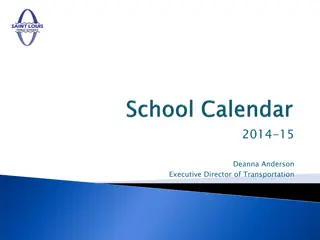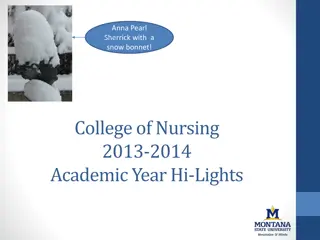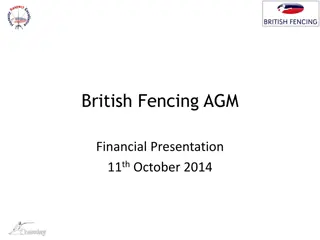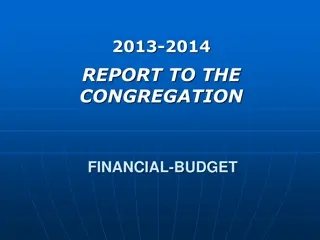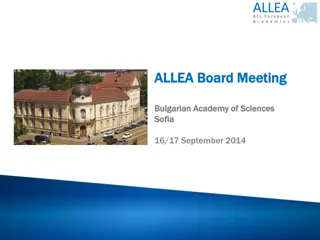
Evolution of Geometry Textbooks in US High Schools since 1960
Explore the transformations in US commercial high school geometry textbooks since 1960, including the content covered, mathematics courses taken by high school graduates in 2009, and the concepts of transformations and Euclidean geometry. Discover definitions of congruence and similarity using transformations in the context of geometric figures.
Download Presentation

Please find below an Image/Link to download the presentation.
The content on the website is provided AS IS for your information and personal use only. It may not be sold, licensed, or shared on other websites without obtaining consent from the author. If you encounter any issues during the download, it is possible that the publisher has removed the file from their server.
You are allowed to download the files provided on this website for personal or commercial use, subject to the condition that they are used lawfully. All files are the property of their respective owners.
The content on the website is provided AS IS for your information and personal use only. It may not be sold, licensed, or shared on other websites without obtaining consent from the author.
E N D
Presentation Transcript
Transformations in U.S. Commercial High School Geometry Textbooks since 1960 A Brief Report International Conference on Mathematics Textbooks University of Southampton 31 July 2014 by Zalman Usiskin The University of Chicago z-usiskin@uchicago.edu
Mathematics courses taken by U.S. high school graduates (2009) Grade Better students Algebra (1styear) Average students Other students 8thgrade math 8 Prealgebra Algebra (1styear) 9 Geometry Algebra (2ndyear) Precalculus Prealgebra Algebra (1styear) Geometry 10 11 Geometry Algebra (2ndyear) 12 Calculus Precalculus Red indicates that the course is required for high school graduation in most states. In 2009, 18% of high school graduates had completed calculus, 35% had completed precalculus, and 76% had completed a second year of algebra. About 85% take a one-year geometry course; perhaps 5% study an integrated curriculum.
Content in almost all U.S. geometry texts since 1960 (the scope of this study) properties of points, lines, and planes angles, parallel and perpendicular lines triangle congruence, including proof properties of special quadrilaterals (parallelograms, etc.) similar triangles and similar polygons, including regular polygons properties of segments and angles in circles figures in 3-dimensional space (prisms, pyramids, cones, cylinders, spheres) area, surface area, and volume coordinate geometry (figures on the coordinate plane) indirect proof.
Transformations and Euclidean geometry Transformation = 1-1 function that maps point of a set F onto a set G. Euclidean geometry = study of those properties of figures preserved by transformations that preserve ratios of distances (Felix Klein, 1872) Similarity transformation = transformation that preserves ratio of distances = distance-multiplying transformation Isometry = distance-preserving transformation = similarity transformation with multiplier 1.
Definitions of congruence and similarity using transformations Two figures and are congruent if and only if there is a distance-preserving transformation (isometry) that maps onto . Two figures and are similar if and only if there is a distance-multiplying transformation (similarity transformation) that maps onto .
Curriculum and Evaluation Standards for School Mathematics (NCTM, 1989) (all students) deduce properties of figures using transformations; identify congruent and similar figures using transformations; analyze properties of Euclidean transformations and relate translations to vectors. (college-intending students) apply transformations in problem solving.
Principles and Standards for School Mathematics (NCTM, 2000) (all students) understand and represent translations, reflections, rotations, and dilations of objects in the plane by using sketches, coordinates, vectors, function notation, and matrices; use various representations to help understand the effects of simple transformations and their compositions.
Common Core State Standards for Mathematics (National Governors Association and Council of Chief State School Officers, 2010) http://www.corestandards.org/the-standards/mathematics Three clusters of standards:* A. Experiment with transformations in the plane. (4 standards) B. Understand congruence in terms of rigid motions. (3 standards) C. Understand similarity in terms of similarity transformations. (3 standards) *Detail is given on slides 28 and 29 of this ppt.
THE RAW DATA 64 geometry texts published commercially in the U.S. from 1961 to 2015
Mean length* of 62 geometry textbooks 1961-2015 1960s 1970s 1980s 1990s 2000s 2010s 14 18 9 9 6 6 Number of textbooks 612 636 697 765 851 956 Mean length (pages) *Length includes all features but does not include introductory material (title page, table of contents, etc.). Two experimental texts not included.
Four analyses of the data 1. Extent of opportunities to encounter geometric transformations 2. Scope and language of transformations in the texts that discussed them 3. Coverage of six basic reasons for studying transformations 4. Attention to specific activities mentioned in the U.S. Common Core Standards of 2010
Treatment of transformations in 62 geometry textbooks 1961-2015 1960s 1970s 1980s 1990s 2000s 2010s Totals No treatment 11 5 1 1 0 0 18 One lesson only One chapter at end of book One chapter in middle, unconnected In various places, unconnected 0 2 1 1 0 0 4 1 5 5 3 2 0 16 0 4 0 2 1 1 8 1 1 2 0 1 4 9 Treatment throughout 1 1 0 2 2 1 7 Totals 14 18 9 9 6 6 62
Treatment of transformations in 62 geometry textbooks 1961-2015 1960s 1970s 1980s 1990s 2000s 2010s Totals No treatment 11 5 1 1 0 0 18 One lesson only One chapter at end of book One chapter in middle, unconnected In various places, unconnected 0 2 1 1 0 0 4 1 5 5 3 2 0 16 0 4 0 2 1 1 8 1 1 2 0 1 4 9 Treatment throughout 1 1 0 2 2 1 7 Totals 14 18 9 9 6 6 62
Treatment of transformations in 62 geometry textbooks 1961-2015 1960s 1970s 1980s 1990s 2000s 2010s Totals No treatment 11 5 1 1 0 0 18 One lesson only One chapter at end of book One chapter in middle, unconnected In various places, unconnected 0 2 1 1 0 0 4 1 5 5 3 2 0 16 0 4 0 2 1 1 8 1 1 2 0 1 4 9 Treatment throughout 1 1 0 2 2 1 7 Totals 14 18 9 9 6 6 62
Culling down the sample 64 texts in collection -2 texts deemed purely experimental = 62 texts in sample -22 texts that do not discuss transformations in more than a few pages = 40 texts discuss transformations in a full chapter or more
Four analyses of the data 1. Extent of opportunities to encounter geometric transformations 2. Scope and language of transformations in the texts that discussed them 3. Coverage of six basic reasons for studying transformations 4. Attention to specific activities mentioned in the U.S. Common Core Standards of 2010
Definition of transformation in 35 geometry textbooks 1961-2015 Transformation identified as Textbooks numbered (in date of publ. order) 10, 17, 23, 37, 44, 46, 48, 58 11, 22, 25, 28, 32, 38, 41, 49, 52, 53, 59 Number of textbooks F U N C T I O N S Y N O N Y M S Mapping 8 Correspondence 11 Function 27, 34, 42, 47, 64, 66 6 Operation 21, 61, 65 3 Set of ordered pairs 30 1 Matching 45 1 Process 63 1 Movement or change 54, 55, 56, 62 4
Scope and language of transformations Euler s f( ) function notation in 12 of 35 texts that define transformations. 37 of the 40 texts discuss composition of transformations, calling the answer: composition (17 texts), composite (9), product (6), combination (2), resultant (1), with 1 text using two of these names and three texts giving no special name.
Scope and language of transformations (more) Of the 40 texts, 22 mention all four types of isometries (reflections, translations, rotations, and glide reflections); 18 mention all but glide reflections. The transformation T that fixes a single point C, and for which the image of P is the point P on ray CP so that CP = k CP is almost universally called a dilation (other names: dilatation, size change, size transformation, expansion). If k > 1, an expansion, enlargement, or stretch; if k < 1, a contraction, a reduction, or a shrink.
Four analyses of the data 1. Extent of opportunities to encounter geometric transformations 2. Scope and language of transformations in the texts that discussed them 3. Coverage of six basic reasons for studying transformations 4. Attention to specific activities mentioned in the U.S. Common Core Standards of 2010
Basic reasons for studying transformations (1) They enable single definitions of congruence and similarity to apply to all figures. (2) They are functions, so can provide experience with function notation and composition. (3) They provide a mathematical explanation of symmetry. (4) They provide mathematical models of real-world actions. (5) They solve problems that might be more difficult to solve without them.
The most common shortest distance problem solved using transformations Find the path of shortest total length from A to B that intersects line m. .B A. m
Basic reasons for studying transformations (1) They enable single definitions of congruence and similarity to apply to all figures. (2) They are functions, so can provide experience with function notation and composition. (3) They provide a mathematical explanation of symmetry. (4) They provide mathematical models of real-world actions. (5) They solve problems that might be more difficult to solve without them. (6) There are interesting and important algebraic relations involving them.
Numbers of texts discussing various aspects of transformations One chapter at end of book (n = 16) One chapter in middle (n = 8) Various places, unconnected (n = 9) Treatment throughout (n = 7) Symmetry is explained using transformations. 11 6 8 7 Transformations model the real world. 7 5 3 7 Shortest distance problem solved using reflections. 5 0 4 5 Algebra of transformations is discussed. 1 1 0 5
Four analyses of the data 1. Extent of opportunities to encounter geometric transformations 2. Scope and language of transformations in the texts that discussed them 3. Coverage of six basic reasons for studying transformations 4. Attention to specific activities mentioned in the U.S. Common Core Standards of 2010
Degree of coverage of transformation activities now in Common Core Activity Degree of attention in 40 texts Cluster: Experiment with transformations in the plane. Few specifically mention functions. Coverage rare. 1. Give a definition of transformation as a function from points of the plane into points of the plane. 2. Compare transformations that preserve distance and angle to those that do not (e.g., translation versus horizontal stretch). 3. Describe the rotations and reflections that map rectangles, parallelograms, trapezoids, and regular polygons onto themselves. 4. Give definitions of rotations, reflections, and translations in terms of angles, circles, perpendicular lines, parallel lines, and line segments. 5. Given a geometric figure and a rotation, reflection, or translation, draw the transformed figure using, e.g., graph paper, tracing paper, or geometry software. 6. Given two congruent figures, determine a transformation or sequence of transformations that will map one figure onto another. 8 texts mention all the symmetries. In almost all texts. In almost all texts. In 18 texts.
Degree of coverage of transformation activities now in Common Core Activity Degree of attention in 40 texts Cluster: Understand congruence in terms of rigid motions. In almost all texts. 7. Use geometric descriptions of rigid motions to transform figures. 8. Deduce ASA, SAS, and SSS congruence through isometries. In 9 texts. Cluster: Understand similarity in terms of similarity transformations. Difficult to determine; drawings in almost all texts that discuss dilations. 9. Draw to show that a line not containing the center and its dilation image are parallel and to show that a line containing the center and its dilation image coincide. 10. Draw to show that the ratio of the length of a dilation image to the length of its preimage equals the scale factor of the dilation. 11. Deduce AA similarity through similarity transformations. In 8 texts.
Summary High school mathematics teachers in the U.S. today are unlikely to have studied geometric transformations as high school students. The language and approaches of the material in books that cover transformations vary significantly. Only a few of the activities in the Common Core are likely to be familiar to teachers. Professional development will be necessary for most teachers if this content is to be taught to students in the manner dictated in the Common Core.
Comments and questions are welcome! z-usiskin@uchicago.edu




